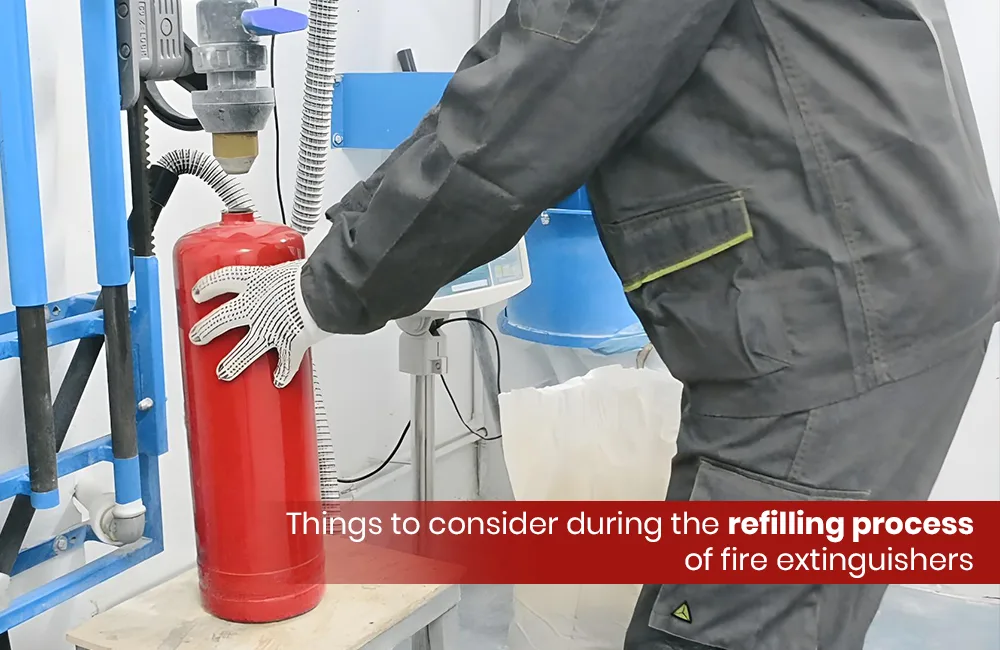Fire extinguishers are one of the simplest tools for first fire response; in putting out minor fires so they will not develop into major fires. Regular refilling of fire extinguishers enables them to perform when it is needed most. The blog aims to guide take you through the fire extinguisher refilling requirements.
The things to consider during the refilling process are:
Check the parts used
When being refilled, each part must be checked to know that the unit is in perfect working condition and safe for use.
Valves: They must be leak-free, crack-free, or free of any type of damage.
Hose & Nozzle: Obstruction or cracking that may inhibit flow of the extinguishing medium needs to be inspected.
Pressure Gauge: Inspect that it’s reading within the range indicated and in good working condition.
Seals and Pins: These safety devices should be unbroken and intact to verify that the extinguisher has not been discharged accidentally.
Refilling test of fire extinguisher
An adequate test should be performed prior to refilling a fire extinguisher to verify the structural integrity and safety of the device. Pressure test, or hydrostatic test, is carried out by filling the extinguisher with water or other incompressible fluid and pressurizing it to a certain extent to identify any leaks, bulging, or points of failure. Also inspect the inside of the cylinder for rust, corrosion, or internal damage, which can hinder the safety and effectiveness of the extinguisher.
Every cylinder has a defined shelf life, which ensures its safety. If a cylinder has reached or exceeded its shelf life, it is not safe to refill and must be taken out of service. Attempting to refill an expired cylinder can cause serious safety risks, including the chance for leaks or explosions.
Ensure proper handling and storage conditions
The extinguishers should be placed in upright positions in easily accessible and visible positions. They should be stored in a cool dry place or protected from high temperatures or harmful chemicals, if possible, in the -10°C to 50°C temperature range based on the extinguishing agent. Upon refilling, the experts may utilize the proper personal protective equipment (PPE) of gloves, goggles, and protective devices to confirm that they will be safe from pressurized contents and chemicals.
Inspect the expiry dates
Perhaps the most important procedure in the fire extinguisher refilling checklist is checking on the expiry date of the extinguishing agent and of the unit itself. All extinguisher types such as dry powder, foam, CO₂ or wet chemical all have a recommended service or refill period, generally 3 to 5 years based on type and manufacturer recommendation. Don’t forget that even though an extinguisher may have never been used, it should be inspected and serviced regularly.
Refill with the correct type of agent
Recharging a fire extinguisher with the right kind of extinguishing agent is necessary because different agents are meant to put out different classes of fire. The wrong agent for the extinguisher can result in improper extinguishing of fire, equipment damage, or even start the fire. Incorrect refilling can cause pressure imbalance, nozzle blockages, or improper spray patterns.
Verify the weight after refilling
In refilling a fire extinguisher, one needs to find the final weight to that the right quantity of extinguishing agent has been added. A unit that is underfilled will not discharge enough agent to put out the fire, and an overfilled unit may result in pressure or mechanical failure.
For weight verification, use a calibrated weight device and compare the reading to the manufacturer’s marked full weight (usually on the body of the extinguisher).
Test the functionality
Recharging a fire extinguisher comes with the necessity of conducting a functional test as a precautionary measure to find out whether it will function efficiently in case of emergencies. A functional test ensures issues such as blockage, faulty valves, or leakage are identified prior to reutilization.
Even though discharge testing to full capacity is not required after every refill, there should be a functional test in routine maintenance, typically once a year or as stipulated by safety legislation and the extinguisher manufacturer.
Certification and compliance
It is essential that the refilling of the fire extinguisher process align with local fire safety standards to guarantee security and prevent legal complications. Refilling should always be carried out by professionals who have been trained and certified in understanding BIS standards and can service pressurised systems safely.
Documentation and record keeping
Correct and proper documentation is part of the requirement in refilling and maintaining fire extinguishers. Each refill will have to be followed by a full set of records, with the record in the form of a maintenance log, required for regulatory purposes and safety audits.
A properly kept logbook helps to track the service history of all the extinguishers so that they are inspected and recharged at regular intervals as per standards. It also helps to identify recurring problems, schedule future services, and demonstrate compliance to fire safety inspections by local authorities.
A fire extinguisher refilling checklist guarantees that all significant steps are followed to ensure maximum safety and compliance. Fire extinguisher maintenance and refilling are the essential things to consider during the refilling process in preventing fire-extinguishing equipment from failing when it is required. A well-maintained extinguisher can save lives by preventing a fire from spreading.
Safetik provides the finest fire and safety services in Kerala, catering to many industries. With over 20 years of experience, they want to provide good service by being ahead in business.

